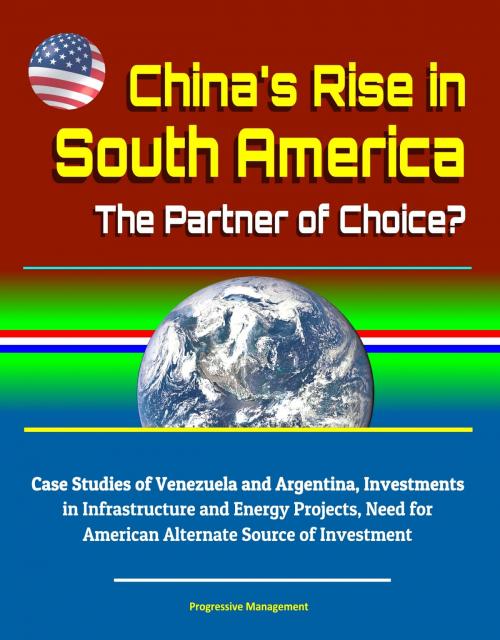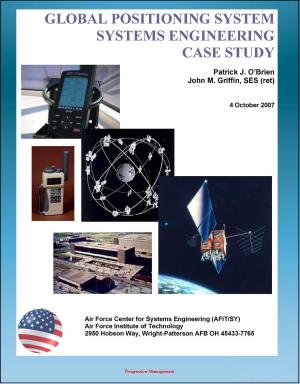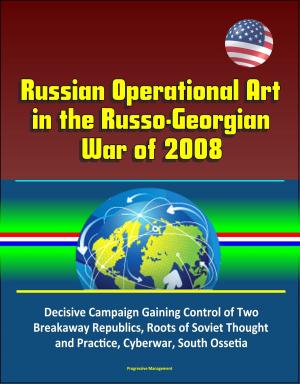China's Rise in South America: The Partner of Choice? Case Studies of Venezuela and Argentina, Investments in Infrastructure and Energy Projects, Need for American Alternate Source of Investment
Nonfiction, History, Americas, Latin America, Asian, China| Author: | Progressive Management | ISBN: | 9780463753149 |
| Publisher: | Progressive Management | Publication: | June 14, 2018 |
| Imprint: | Smashwords Edition | Language: | English |
| Author: | Progressive Management |
| ISBN: | 9780463753149 |
| Publisher: | Progressive Management |
| Publication: | June 14, 2018 |
| Imprint: | Smashwords Edition |
| Language: | English |
This important 2018 report has been professionally converted for accurate flowing-text e-book format reproduction.
As Chinese investment in South America has grown exponentially and influenced the region, has South America benefited from the investment? This paper features case studies of both Venezuela and Argentina to illustrate how Chinese investment has had different effects on these two economies. Venezuela has relied heavily on loans-for-oil to fuel its socialist economy and feed its political structure, resulting in very negative outcomes. On the other hand, Argentina has channeled Chinese investment mostly into infrastructure, such as energy diversification projects, with the construction of two hydroelectric dams, two nuclear reactors, and upgrades to its outdated railway systems. Chinese investment can boost South American economies if it is used for infrastructure that will lead to less reliance on additional Chinese loans. Unfortunately, both countries rely heavily on raw material exports and need to ensure that manufacturing and technology-based jobs are not lost in the process. As China gains more influence in the region, the United States needs to provide alternate sources of investment and bring to light the pitfalls created by the current Sino-South America partnership.
I. INTRODUCTION * A. SIGNIFICANCE OF THE RESEARCH QUESTION * B. LITERATURE REVIEW * 1. South America's Pursuit of Fiscal and Political Autonomy from United States * 2. China's Interests in South American Investment * C. ARGUMENT * D. RESEARCH DESIGN * II. CHINA'S "GOING-OUT": CHANGING GLOBAL INFLUENCE IN THE WESTERN HEMISPHERE * A. CHINA'S STATE-OWNED "NATIONAL CHAMPIONS" AND THEIR WORLDWIDE INFLUENCE * B. CHINA DEVELOPMENT BANK IN SOUTH AMERICA * C. POLITICAL-ECONOMIC MOTIVATIONS FOR CHINESE OVERSEAS INVESTMENT IN SOUTH AMERICA * D. LATIN AMERICA'S INTEREST IN CHINESE INVESTMENT * III. VENEZUELA'S TRADE AND INVESTMENT FAILURES WITH CHINA: A CASE STUDY * A. CHINA'S INTERESTS IN VENEZUELA * B. VENEZUELA'S INTERESTS IN CHINA * C. CHARACTERISTICS OF CHINA'S ATTRACTIVE LOANS (THAT LEAD TO INCREASED INVESTMENT) * D. RESULTS OF THE SINO-VENEZUELAN RELATIONSHIP * E. CONCLUSION * IV. A CASE STUDY OF ARGENTINA'S DIVERSIFIED CHINESE INVESTMENT * A. CHARACTERISTICS OF CHINESE INVESTMENTS AND LOANS IN ARGENTINA * B. CHINA'S INTERESTS IN ARGENTINA * C. ARGENTINA'S INTERESTS IN CHINA * D. ARGENTINA'S GOVERNMENT DRIVEN BY SOY TAXATION * E. EFFECTS OF CHINESE INVESTMENT IN ARGENTINA * F. CONCLUSION * V. SOUTH AMERICA'S GRAVITATION TO THE CHINESE ORBIT: WHAT CAN THE UNITED STATES DO? * A. MIXED RESULTS FROM CHINESE INVESTMENT DUE TO INSTITUTIONAL CONSTRAINTS * B. MARKETS, INVESTMENTS, AND RELATIONS * INCREASINGLY AT STAKE FOR THE UNITED STATES * C. U.S. NATIONAL DEFENSE STRATEGY'S NEED FOR A GOOD NEIGHBOR POLICY FOR THE 21ST CENTURY * D. APPROACHES THE UNITED STATES CAN IMPLEMENT TO CREATE A GOOD NEIGHBOR POLICY * 1. Passive Role * 2. Active Role * E. CONCLUSION
This important 2018 report has been professionally converted for accurate flowing-text e-book format reproduction.
As Chinese investment in South America has grown exponentially and influenced the region, has South America benefited from the investment? This paper features case studies of both Venezuela and Argentina to illustrate how Chinese investment has had different effects on these two economies. Venezuela has relied heavily on loans-for-oil to fuel its socialist economy and feed its political structure, resulting in very negative outcomes. On the other hand, Argentina has channeled Chinese investment mostly into infrastructure, such as energy diversification projects, with the construction of two hydroelectric dams, two nuclear reactors, and upgrades to its outdated railway systems. Chinese investment can boost South American economies if it is used for infrastructure that will lead to less reliance on additional Chinese loans. Unfortunately, both countries rely heavily on raw material exports and need to ensure that manufacturing and technology-based jobs are not lost in the process. As China gains more influence in the region, the United States needs to provide alternate sources of investment and bring to light the pitfalls created by the current Sino-South America partnership.
I. INTRODUCTION * A. SIGNIFICANCE OF THE RESEARCH QUESTION * B. LITERATURE REVIEW * 1. South America's Pursuit of Fiscal and Political Autonomy from United States * 2. China's Interests in South American Investment * C. ARGUMENT * D. RESEARCH DESIGN * II. CHINA'S "GOING-OUT": CHANGING GLOBAL INFLUENCE IN THE WESTERN HEMISPHERE * A. CHINA'S STATE-OWNED "NATIONAL CHAMPIONS" AND THEIR WORLDWIDE INFLUENCE * B. CHINA DEVELOPMENT BANK IN SOUTH AMERICA * C. POLITICAL-ECONOMIC MOTIVATIONS FOR CHINESE OVERSEAS INVESTMENT IN SOUTH AMERICA * D. LATIN AMERICA'S INTEREST IN CHINESE INVESTMENT * III. VENEZUELA'S TRADE AND INVESTMENT FAILURES WITH CHINA: A CASE STUDY * A. CHINA'S INTERESTS IN VENEZUELA * B. VENEZUELA'S INTERESTS IN CHINA * C. CHARACTERISTICS OF CHINA'S ATTRACTIVE LOANS (THAT LEAD TO INCREASED INVESTMENT) * D. RESULTS OF THE SINO-VENEZUELAN RELATIONSHIP * E. CONCLUSION * IV. A CASE STUDY OF ARGENTINA'S DIVERSIFIED CHINESE INVESTMENT * A. CHARACTERISTICS OF CHINESE INVESTMENTS AND LOANS IN ARGENTINA * B. CHINA'S INTERESTS IN ARGENTINA * C. ARGENTINA'S INTERESTS IN CHINA * D. ARGENTINA'S GOVERNMENT DRIVEN BY SOY TAXATION * E. EFFECTS OF CHINESE INVESTMENT IN ARGENTINA * F. CONCLUSION * V. SOUTH AMERICA'S GRAVITATION TO THE CHINESE ORBIT: WHAT CAN THE UNITED STATES DO? * A. MIXED RESULTS FROM CHINESE INVESTMENT DUE TO INSTITUTIONAL CONSTRAINTS * B. MARKETS, INVESTMENTS, AND RELATIONS * INCREASINGLY AT STAKE FOR THE UNITED STATES * C. U.S. NATIONAL DEFENSE STRATEGY'S NEED FOR A GOOD NEIGHBOR POLICY FOR THE 21ST CENTURY * D. APPROACHES THE UNITED STATES CAN IMPLEMENT TO CREATE A GOOD NEIGHBOR POLICY * 1. Passive Role * 2. Active Role * E. CONCLUSION















